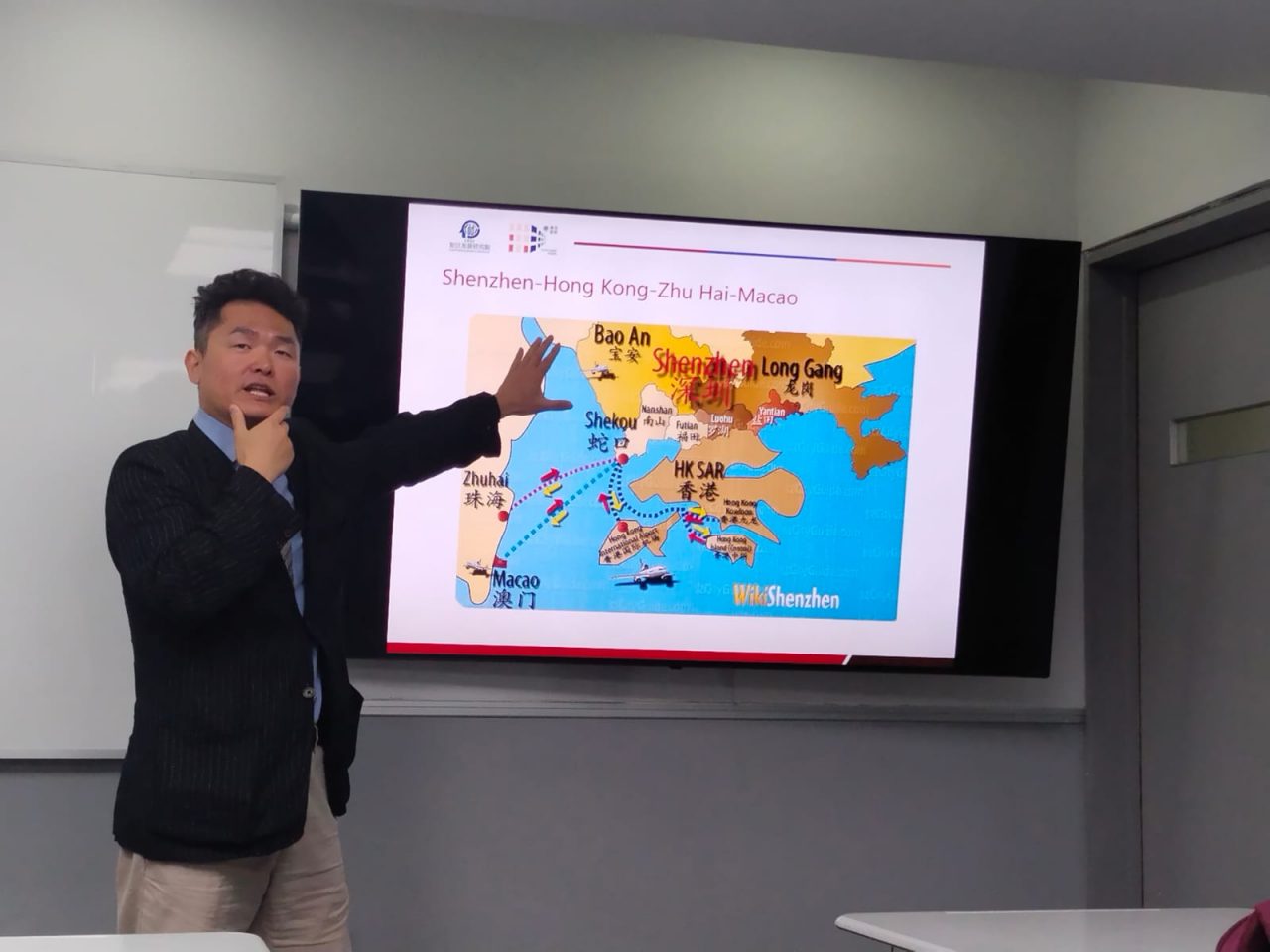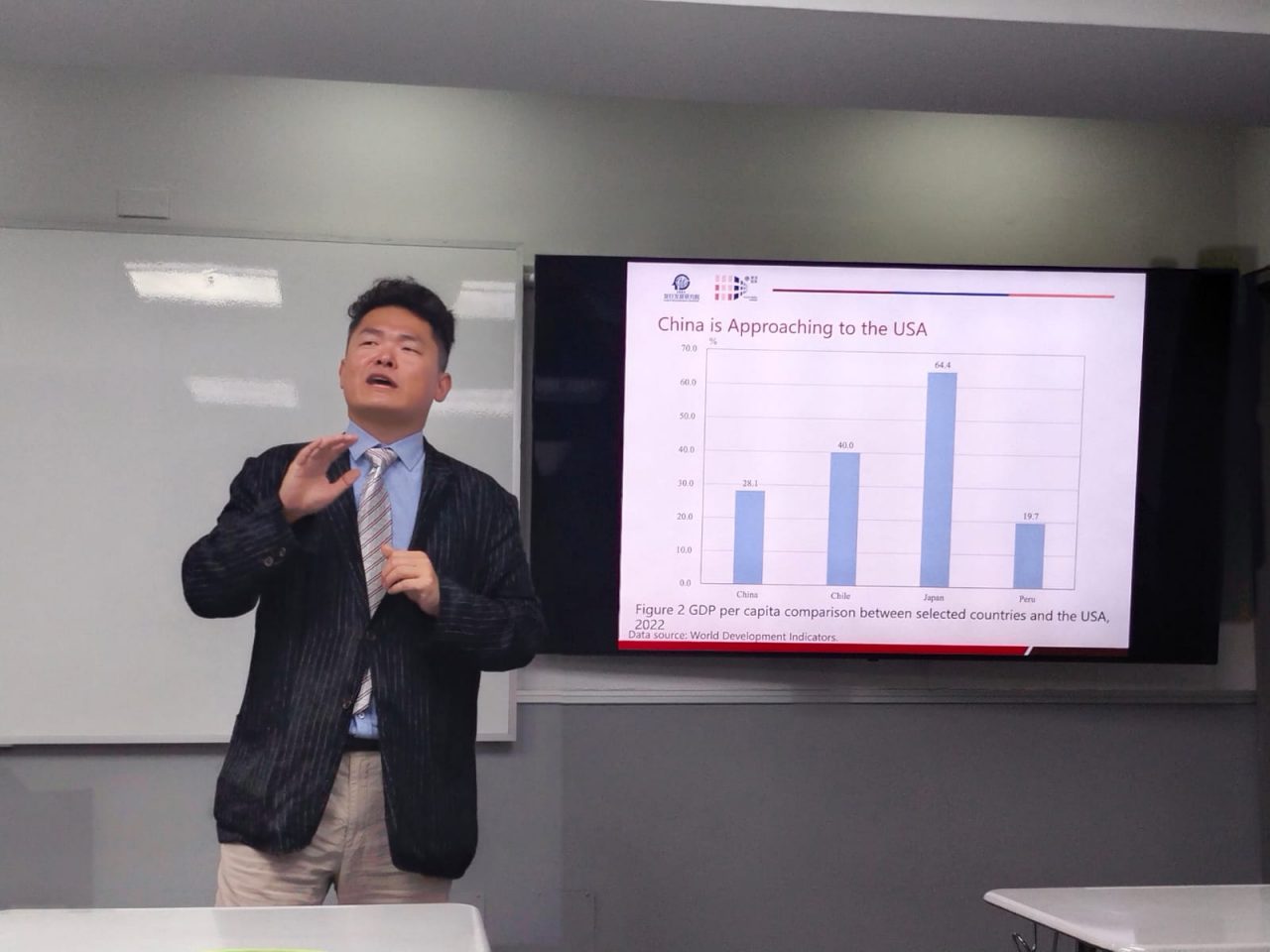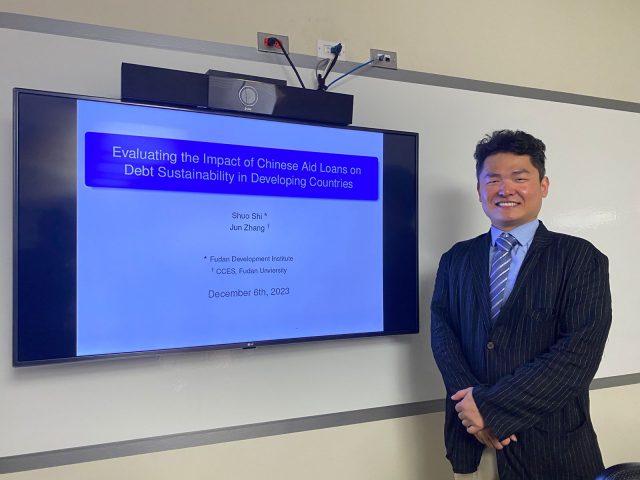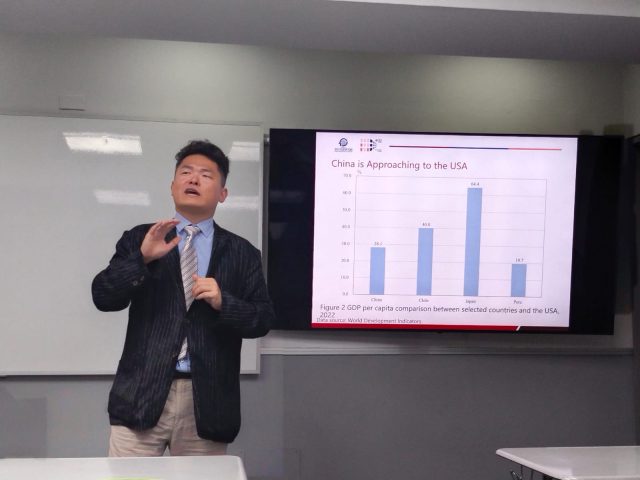Dr. Shi Shuo of the Fudan Development Institute is a visiting scholar at the Center
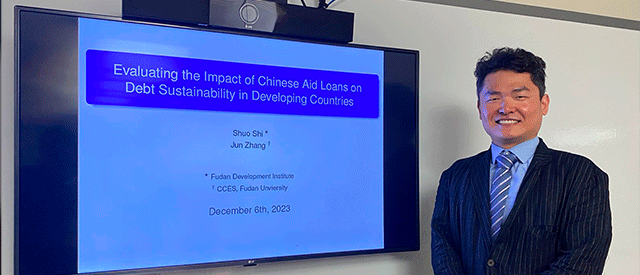
On Wednesday, December 6, Dr. Shi Shuo, our visiting scholar from the Fudan Development Institute (FDDI), one of the most recognized Think Thanks in China, presented a preview of his research titled “Evaluating the Impact of Chinese Aid Loans on Debt Sustainability in Developing Countries”.
Dr. Shi has developed various research in development economics, international cooperation, macroeconomics, and the Chinese economy. He has written articles on the topics of the China-US trade war, capital strategy of state-owned enterprises, ESG development, and his opinions have been published in major Chinese financial media such as Financial Times China, Fudan Financial Review, among others.
Dr. Shi is staying at the Center for China and Asia-Pacific Studies (CECHAP) from October 2023 to April 2024, in addition to promoting collaboration between Fudan University and Universidad del Pacífico (UP).
Below, we share an interview about his academic stay at UP:
Dr. Shi, how was your invitation to the Center for China and Asia-Pacific Studies?
It is a great honor for me to visit the UP Center for China and Asia-Pacific Studies. In March I received the kind invitation and presented my research program and finally the acceptance to spend six months here.
The title of my research plan at the Center is “Evaluating the Impact of Chinese Aid Loans on Debt Sustainability in Latin America Countries”. Basically, this project focuses on Chinese loans and their impact on debt issues in this region. I am very excited to carry out this research and share my findings with Peruvian academics and students.
How will you promote collaboration between Fudan University and Pacific University?
UP is one of the best universities in Peru and in Latin American countries. Fudan University is very interested in cooperating with UP. In fact, UP has joined the Fudan-Latin America University Consortium (FLAUC) as a very active member. This consortium is led by Fudan University, specifically operated by the Fudan Development Institute (FDDI). Moreover, the China Center for Economic Studies (CCES), Fudan University has also joined the Advisory Council of CECHAP. In sum, the bilateral cooperation has great potentials.
I believe that CECHAP, FDDI, and CCES can propose exchange and joint research programs to promote our cooperation step by step through the FLAUC. And I also hope that in the future, Fudan University and UP can establish deep cooperation at the university level.
What are your UP-related plans for your academic research?
The CECHAP of the UP is very active on Chinese studies in Latin America, and I have attended several seminars, symposiums and forums held by it, where I had learned greatly from the brilliant speakers and participants.
It has been suggested to me by the UP CECHAP to do the research comparatively. Perhaps I need to compare China’s loans and/or Chinese Foreign Direct Investment (FDI) inflows, in Peru with other countries in the Latin America and check the relationships and/or effects.
What does your recent research consist of and what will perhaps be your next steps in this regard?
The international community is increasingly concerned that China has provided too many loans to developing countries. With debt problems, people are worried about China’s overwhelming commercial loans and official loans which may lead to more debt risks in Latin American countries. But, will this happen?
That’s basically my research question. As an economist, I would like to use econometric and empirical tools to analyse the effect of Chinese loans on the debt burden in Latin American countries, which in the last two decades have been one of the largest loan recipient regions of Chinese overseas loans.
Why exactly do Latin American countries need so many Chinese loans? It is a very interesting question. Historically, the region has long been one of the main recipient regions of loans from the US and Europe, but now, the existence of loans from China has been increasing.
This raises some geopolitical concern, especially among African, American, and European politicians. Some notion states that China has geopolitical ambitions to establish a hegemony or superpower in this region. Therefore, the massive issuance of FDI and official loans is one of China’s “tools” to increase its influence over this area. That is why, I feel the need to start analysing the impact of Chinese FDI and Chinese overseas loans in this area. Perhaps these financing flows could trigger a debt crisis or a financial crisis in these developing countries; However, my preliminary empirical evidence show that Chinese loan inflows can increase fiscal revenues and reduce debt stock in Latin American countries.
According to my empirical evidence, the increase in fiscal revenues is much greater than the increase in fiscal expenditures, which means the recipient governments can earn more than they spends. As a result, the recipient governments c will save more by receiving Chinese loans. With Chinese loans, the recipient governments are indebted to China, but those Chinese loans can also finance infrastructure projects like railways, highways, ports, airports, or other important infrastructure projects in this region. Chinese loans can underpin the formulation of critical public assets that will help developing countries generate more profits and more employment opportunities, and even greater social well-being for the local communities.
What do you recommend so that Peru can begin competitive economic growth, with China as a reference?
Peru has focused on the export of agricultural and mineral products, but casts very limited attention on the growth in Peruvian manufacturing sectors, even though there was some innovation growth in manufacturing sectors presented by other Peruvian scholars. But compared to China, Peruvian growth in manufacturing is insufficient for the country to pursue a high-quality growth track. Maybe the reason behind is that Peru still relies on the so-called import substitution strategy rather than the export-oriented strategy’. In other words, Peruvian firms in manufacturing substitute imports from the world market with domestic products, and many of its manufacturing sectors are focused on domestic markets. Moreover, its manufacturing companies have very limited access to the global market. As a result, the exports of Peruvian manufactured products to developed countries are still very small (compared to China).
Peruvian manufacturing should expand its role in global value chains. Some of Peruvian manufacturing products may remain very competitive, but Peru need to contribute more to global value chains and increase its value added to further boost its economic growth. To shift the Peruvian role in global value chains, Peru should consider an export-oriented strategy, link its manufacturing sectors to other high-value added producers, and upgrade its strategic ports to the dynamic Asia-Pacific region.
The manufacturing sector is key for economic growth and even the global order. Why the United States struck a trade war with China? An important reason is that more and more Chinese manufacturing firms in high-tech fields become strategically competitive from the American perspective. If Peru intends to export a larger leverage in the Asia-Pacific region, promoting a highly competitive manufacturing sector in global value chains is much more critical than ever.
In your opinion, what is the value between UP and the Center for China and Asia-Pacific Studies about bringing visiting scholars like yourself?
The UP Center for China and Asia-Pacific Studies is one of the leading research institutions that focuses specifically on Chinese issues and studies. The Center covers many fields of study such as economics, international relations, political science, and energy, as well as other very important topics, which is why it has always been important to invite international academics to visit the Center and share their research on topics of mutual interest.
I would like to contribute economic insights into the effects of Chinese loans in Latin America and share the results of my research with the Center. Also, I will present the Center to Chinese academics, especially at my Institute, and encourage my colleagues to have more joint programs with the Center to establish comprehensive cooperation between China and Peru, especially between Fudan University and UP, and of course between Fudan Development Institute and the Center for China and Asia-Pacific Studies.

